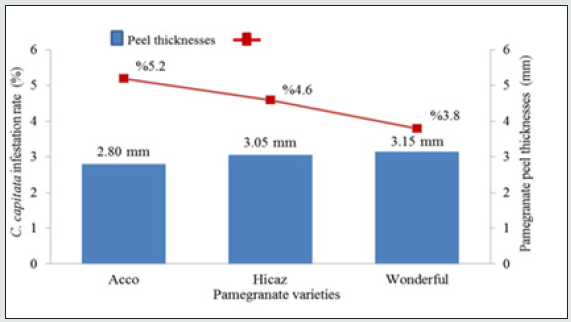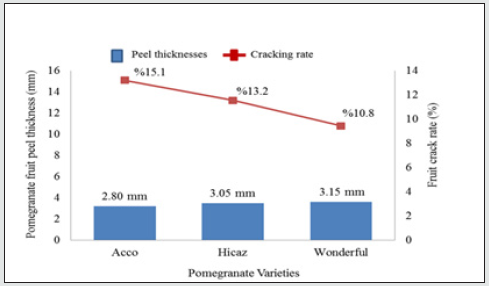
Lupine Publishers Group
Lupine Publishers
Menu
ISSN: 2637-4676
Research Article(ISSN: 2637-4676) 
Population Fluctuation of Mediterranean Fruit Fly, Ceratitis capitata Wied (Diptera: Tephritidae) on Different Pomegranate (Punica granatum L.) Varieties by Pheromone Traps and Associated Loss Assessment Volume 9 - Issue 5
Murat Aslana M*, Aziz Kasapb
- Department of Plant Protection, Faculty of Agriculture, Kahramanmaraş Sütçü İmam University, Kahramanmaraş, Turke
Received: October 13th , 2021; Published: October 22nd, 2021
Corresponding author: M Murat Aslan, Department of Plant Protection, Faculty of Agriculture, Kahramanmaraş Sütçü İmam University, Kahramanmaraş, Turkey
DOI: 10.32474/CIACR.2021.09.000322
Background
Mediterranean fruit fly, Ceratitis capitata Wied (Diptera: Tephritidae) is considered as one of the most deleterious fruit pests which may cause high pomegranate, Punica granatum L. yield losses in Turkey. Monitoring population density of herbivore insects is a significant element of integrated pest management strategies. Therefore, C. capitata population fluctuation was monitored via a SEDQ yellow trap + pheromone in a pomegranate orchard consisted of three cultivars, Acco, Hicaz, and Wonderful, in Seyhan, Adana in 2015. In addition, yield losses were calculated for all cultivars. There was a significant role of pomegranate cultivar on C. capitata catches by traps. Wonderful has the highest number of C. capitata following by Hicaz while traps in Acco caught the least number of fly adults. Peel thickness was 3.15, 3.05, and 2.80 mm while cracking level was 10.8%, 13.2%, and 15.1% for Wonderful, Hicaz, and Acco, respectively. In addition, infestation ratios of Wonderful, Hicaz, and Acco were 3.8%, 4.6%, and 5.2%, respectively. There was a significant relationship between fruit peel thickness and fruit cracking level as well as population growth and yield losses. Further efforts should be devoted to cultivar preference of and cultivar resistance against C. capitata for sustainable pest management practices.
Keywords: Cracking; Fruit fly; Generalized linear mixed model; Infestation; Population monitoring
Introduction
Pomegranate is native to the region from Iran to the Himalayas in northern India and cultivated in Turkey, Caucasus, Western Asia, Mediterranean Europe, India, Saharan Africa, North and South America (EPPO, 2019). Turkey is one of the leading countries of pomegranate production in the world. Thanks to increasing awareness of nutritional values, easy to grow and cost-effective care conditions, resistant to long-term storage and export conditions, marketing and processing facilities, pomegranate production has exceeded 500.000 tons in recent years in Turkey (TUIK, [1]). Mediterranean region (53%) of Turkey has more than half of production while Aegean (33 %) and Southeastern Anatolia (12 %) have substantial contributions to Turkish pomegranate production. Accordingly, Turkey hosts many local pomegranate varieties while some other foreign varieties are present in Turkey either for research purposes or commercially. The varieties employed in our study are among the most commonly available commercial varieties in Turkey.
Hicaz variety is the most widely planted, preferred, and exported variety in Turkey. Size of flattened fruits ranges from the middle to large. The peel is thick and its color is red. Grain size is small, grain yield is medium and its juice yield is low to middle. It tastes sour and has hard grains. The variety Wonderful tastes sweet and is rich in the juice which contains the highest rate of anti-oxidants. It has red colored peels and seeds. The fruit size is relatively large. Originally from Israel, Acco variety was introduced many countries including Turkey. Fruits of Acco are early available to consume which lead the increase in preference by farmers. It has a sweet taste with a low acidity level and deep red color in both the peel and the grains. This variety is hard peeled and has smooth seeds. Pomegranate production may be qualitatively and quantitatively restricted by many pests, diseases, and natural enemies. Among diverse pomegranate pests are aphids (Hemiptera: Aphididae), mealybugs (Hemiptera: Pseudococcidae), whitefly (Hemiptera: Aleyrodidae), leafhoppers (Hemiptera: Cicadellidae), scale insects (Hemiptera: Coccidae), leafrollers (Lepidoptera: Tortricidae), fruit borers (Lepidoptera: Pyralidae and Noctuidae), fruit sucking bugs (Hemiptera: Coreidae and Lygaeidae) and fruit flies (Diptera: Tephritidae). The Mediterranean Fruit Fly, Ceratitis capitata Wied (Diptera: Tephritidae) is considered as the most deleterious agricultural pest in the world, has a wide range of cultivated and uncultivated host plants including subtropical fruits, some vegetables, and some ornamental plants (CABI, [2]). The damage of C. capitata to fruits may reach 100%. Besides the feeding damage, C. capitata may transmit fruit-rotting fungi which increase qualitative and quantitative yield losses (Cayol et al., [3]).
As in many other economically important crops, control of C. capitata in pomegranate orchards mostly relies on insecticide applications in Turkey. However, due to resistance and non-target effects of insecticides on organisms, alternative sustainable control strategies are required. Host plant resistance to herbivory is a very important component of integrated pest management strategies especially in horticulture to prevent possible long-term damage. Therefore, population density of C. capitata on Acco, Hicaz and Wonderful varieties of pomegranate were monitored starting from late-May until mid-November of 2015. We employed yellow traps impregnated with pest’s pheromone for weekly samplings. In addition, some pest-associated damage parameters such as dent rates on the fruits and were evaluated.
Material and Method
Study location
The experimental orchards were in Seyhan district of Adana. Population densities of C. capitata were monitored on three varieties of pomegranate, Hicaz, Wonderful, and Acco. Hicaz and Wonderful trees were 9 years old while Acco trees were 5 years old. The distance between trees was 5 × 3 in all orchards. The orchards of Hicaz and Wonderful varieties were 30 da and the orchard of Acco variety was 15 da. Conventional agricultural practices were performed in all orchards and pesticides were used against diseases and pests at certain periods and it was detected that the number of C. capitata decreased as a result of pesticide application.
Population monitoring and sampling procedure
Ceratitis capitata population densities were monitored via pheromone traps which consisted of yellow bucket type traps, traps apparatus and sex pheromone (Ammonium salts (7.8 g Ammonium acetate + 1,04 Triethylamine hydrocloride) + 0.034 g Cadavarin (1,5-diamino pentane) 18 g Attractive feed + 15 mg Deltamethrin disc + trap, Spain) of the pest. Thirteen traps were placed in both orchards of Hicaz and Wonderful varieties and 6 traps were placed in Acco variety orchard with a range of 4 traps per decare in each orchard. The traps were placed on external branches of healthy pomegranate trees at south-southeast direction at a height ranging from 1.40 to 2.00 meters close to fruits. The traps were placed on May 13, 2015 (Blooming period, BBCH scale 61) and removed on November 25, 2015 (leaf fall, BBCH scale 93) (Melgarejo et al., [4]; Meier et al.,[5]). Traps were checked daily to detect first C. capitata adult. C. capitata adults were counted weekly until leaf fall stage. The alive flies in traps were killed and traps were cleaned after sampled.
Fruit Characteristics and C. capitata Associated Loss Assessment
A total of 200 pomegranate fruits were randomly checked visually via a hand magnifier (10×) in each sampling date. Dented fruits were counted and denting direction of fruit was recorded. Damage rate of fruits was calculated the proportioning number of dented fruits to total fruits (200, dented and healthy). The phenological periods and pomological characteristics of fruits were recorded. A caliper compass was employed to calculate pomegranate peel thickness for all varieties.
Statistical Analysis
Weekly insect data were checked for normality (Shapiro – Wilk’s test) and homogeneity of variances (Levene’s test) after log (×+1) transformation prior to the data analysis. Because weekly insect count data do not meet assumptions of linear models, the data were analyzed by fitting generalized linear mixed models (GLMM, lme4 package) with Poisson error distribution (log-link function) to indicate the significance of pomegranate variety, sampling date (Diggle et al., [6]; Bolker et al., [7]; Bates et al., [8]). In the model, variety the collection (sampling) dates were fixed and trap id was a random factor (Bayram and Tonğa, 2018 a and b). Additionally sampling over month effects was tested in the same way that allowed monthly and whole season population density comparisons among tested varieties. A further GLMM analysis was performed for each variety separately (sampling date as fixed and trap id as a random factor) to test the effect of sampling date over the growing season. The fixed factor effects were tested using Wald tests (p < 0.05). Tukey’s post hoc tests (contrasts) were used to compare the means at the 95% confidence level using the glht function of the multcomp package. All statistical computations were done with R software, version 3.4.0 (R Core Team, 2017).
Results
Ceratitis capitata Population Fluctuation on different pomegranate varieties
A total number of 3572, 2900, and 1189 C. capitata adults were caught in traps in pomegranate orchards of Wonderful, Hicaz and Acco varieties, respectively. The first adults of C. capitata were trapped on June 3, May 26, and May 20, 2015, in Wonderful, Hicaz, and Acco varieties respectively (Figure 1). Inconsistent C. capitata population fluctuations were recorded via pheromone traps in all three pomegranate orchards, namely; Hicaz, Wonderful, and Acco throughout 2015 growing season (Figure 1). Flies were present until harvest in orchards of all varieties. Generalized linear mixed model results have revealed that effects of variety, sampling date and their interaction (variety x sampling date) on C. capitata population fluctuations were statistically significant (Fvariety= 34.93, df= 2, P<0.001; Fdate= 111.33, df= 28, P<0.001; Fvariety xdate= 17.35, df= 54, P<0.001). In total, fly density caught in pheromone traps in Hicaz orchard was significantly lower than flies caught by traps in Wonderful orchard (Figure 1A and B). The mean number of flies caught in traps in Hicaz and Acco varieties throughout the season were not significantly different (Figure 1A and B). The number of flies caught in traps set in Acco orchard was significantly lower than those in Wonderful variety in the whole season (Figure 1A and B). Thus, the highest density of C. capitata flies was recorded from traps located in Wonderful orchard (Figure 1A and B).
Figure 1: Population fluctuation of Ceratitis capitata on three different pomegranate varieties (Hicaz, Wonderful, and Acco) as captured by pheromone traps in Seyhan, Adana in 2015.
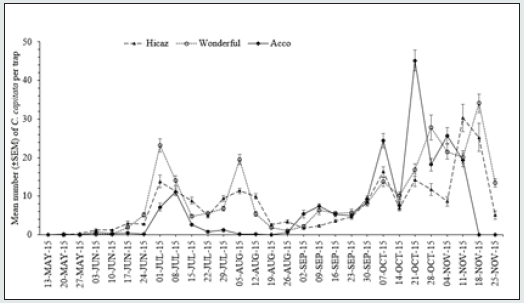
Table 1: Some morphological characteristics of the pomegranate varieties, Hicaz, Wonderful and Acco.

To test differences between C. capitata adult numbers in traps from different pomegranate varieties per month, we considered sampling-associated each month as replications. Monthly fly densities in pomegranate varieties were found statistically different throughout the season except for May (Table 2). Very few number flies were recorded in Hicaz and Acco varieties while no Medfly was caught in traps located and Wonderful in May. The first C. capitata individuals were caught in traps in Wonderful variety in June (Figure 1, Table 2). The mean fly density was lower in Acco than in Hicaz and Wonderful varieties in June, July, and August (Figure 1 and 2a). In September and October, mean C. capitata density was higher in Acco than those of other varieties (Figure 1 and 2a). Hicaz variety had the lowest number of flies in September (Figure 1 and 2a). Number of flies was lowest in Acco variety following by Hicaz while Wonderful had the highest number of C. capitata adults (Figure 1 and 2a).
Figure 2: Monthly (a) and whole season (b) mean (± SEM) number of Ceratitis capitata per pheromone trap on different pomegranate varieties (Hicaz, Wonderful, and Acco).
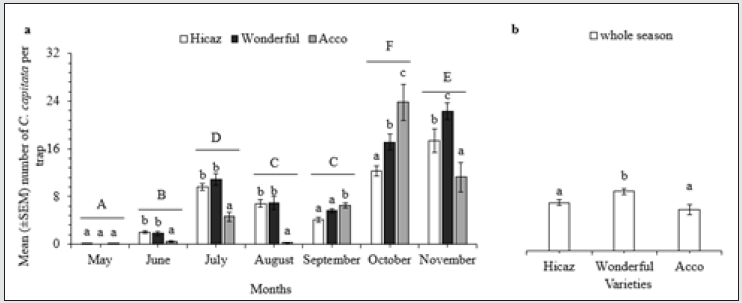
Ceratitis capitata-Associated Loss Assessment
Dates of first dent detection were different on all varieties. For example, first dents were detected on September 09, September 02, and August 19 on Wonderful, Hicaz, and Acco varieties, respectively. Percent of Acco dented fruits was 1.9, 24.0, and 74.0% in August, September, and October, respectively. Percent dented Hicaz variety fruits were recorded as 16.3, 58.6, and 25.0% in September, October, November, respectively. Percent dented fruit numbers of Wonderful variety were 13.1, 59.2, and 27.6% September, October, and November, respectively (Figure 3). Mean damage rates of C. capitata were different on all varieties, for example, the highest damage rate was on Acco variety (5.2%) followed by Hicaz variety (4.6) while the lowest damage rate was on Wonderful variety (3.8%).
Figure 3: The number of pomegranate fruits dented by Ceratitis capitata on the pomegranate varieties (Hicaz, Wonderful and Acco varieties).
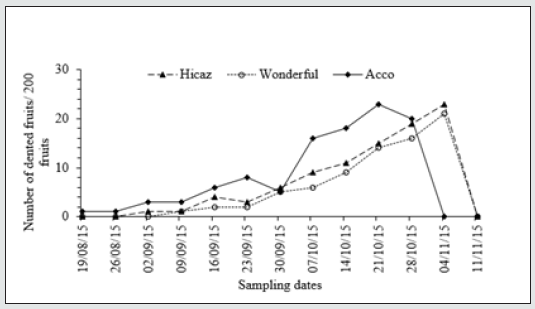
Pomegranate Fruit Peel Thickness
Acco, Hicaz, and wonderful varieties had 2.80, 3.05, and 3.15 mm of peel thickness respectively (Figure 4). Cracks occur on pomegranate depending on the climate, environmental conditions, and variety characteristics; and it has been observed that cracking rate is 15,1% for Acco, 13,2% for Hicaz and 10,8% for Wonderful (Figure 5).
Discussion
During the growing season, inconsistent population fluctuations of C. capitata were recorded by pheromone traps on Hicaz, Wonderful, and Acco pomegranate cultivars starting from late May until end of the harvest lasting. Presence of C. capitata was reported for the same period in pomegranate and persimmon plants in previous work, but the population fluctuations were still inconsistent (Kasap and Aslan). Variations occurred in fly catches on different cultivars although population dynamics were not constant throughout the growing season. Mediterranean fruit fly did not constitute as a threat for early peach varieties which harvesting started at the beginning of May in the Çukurova Region, but it is threat for late maturing varieties, which was harvesting time started at middle of the June (Tiring and Satar, [9]). Population fluctuation of C. capitata adults monitored by pheromone traps relies on factors affecting adult flight. For example, the low density of C. capitata population August and September was likely a result of insecticide treatments. Insecticide treatments were performed since pheromone traps were not efficient enough to control the pest and were employed for population monitoring purposes (Broughton and De Lima, [10]). In addition, the longevity of pheromone releasing sachets which is highly dependent on climatic conditions is another factor requiring special attention since it may influence both numbers of catches over time and insecticide application decision periods (Levinson and Buchelos, [11]; Vanaclocha et al., [12]).
The results of pheromone traps and infestation ratios were inconsistent. Although Wonderful variety had the lowest infestation ratio pheromone traps caught the highest total number of flies in this variety. The reason was probably possible migration of flies from surrounding cultivated C. capitata host fruits such as Japanese plum, apple, blackberry, mandarin, sweet lemon, jujube and fig fruits around wonderful variety (Thomas et al., [13]). Combined with varying infestation ratios, therefore, population monitoring may not reflect cultivar-dependent host preference since infestation ratios highly rely on oviposition preference of the pest. Therefore, the number of flies responding to mate cues and host plant cues may vary as expected. The highest infestation ratio of C. capitata was recorded for Acco cultivar which had highest cracking rate and lowest peel thickness. The cultivar was reported having softest seeds and brightest red color among employed cultivars (Kahramanoğlu and Usanmaz, [14]). Cultivar-dependent physical characteristics such as cracking rate, peel thickness, color, and seed softness may play important roles in host preference (McInnis [15]; Levinson et al. [16]). The studies which have tested the preference of host or host-like experimental tools by C. capitata demonstrated varying results (Katsoyannos et al., Katsoyannos, Prokopy et al.,). The experimental designs of flies’ choice tests were different; therefore, field studies might better represent the fly’s choice in a complex environment.
Date factor (developmental stages, fruit ripening) influenced C. capitata population densities on all pomegranate varieties since fruits ripen in October and November when the greatest population densities were observed. Joachim-Bravo et al. [13] recorded higher oviposition incidence on ripest parts of papayas plants, Carica papaya L. The ripening period of different fruits and its cultivars may differ and, thus, affects population fluctuation of pests. For example, studies conducted in another Mediterranean province, Hatay reported higher population density of C. capitata on different pomegranate varieties in September, October, and November depending on variety (Demirel [17] Demirel, [18]. Further research is required to reveal whether the differences in developmental periods of pomegranate varieties could be benefited as a pest management component. Cracking rate, having possible roles in flies host preference, varied between employed pomegranate varieties. Such morphological characteristics pomegranate fruits may vary depending on variety, climatic conditions or agricultural practices (Kasap ve Aslan, [14]; Singh et al., [19]). Previous research demonstrated that cracking rate may also vary depending on irrigation and kaolin could balance internal water capacity of pomegranate fruits, reduced peel temperature by reflecting ultraviolet lights and, accordingly, reduced cracking rates (Ghanbarpour et al., [20]). Therefore, inducing physiological processes of pomegranate fruits by chemical substances or other stress-related compounds may contribute to fruit protection against C. capitata (Yılmaz and Özgüven, [21]; Khalil and Aly, [22- 35]).
Pest management practices against C. capitata highly depend on cultivar characteristics and success in population monitoring. However, still, further research is required to contribute pomegranate cultivar preference of C. capitata involving host plant physical and chemical properties (host plant volatiles) to construct an ideal pest management tactics [35-44].
Acknowledgements
We express our thanks for the support of Kahramanmaraş Sütçü İmam University (Project no: 2015/1-24YLS). Also we thank Dr. Ahmet Bayram for statistical analysis.
Conflict of Interest
The authors declare no conflict of interest.
References
- TUIK (2019) Pomegranate production in Turkey. Turkish Institute of Statistics.
- CABI (2019) Mediterannnean fruit fly, Ceratitis capitata (Diptera: Tephritidae). Invasive Species Compendium. Detailed coverage of invasive species threatening livelihoods and the environment worldwide.
- Cayol JP, Causse R, Louis C and Barthes J (1994) Medfly Ceratitis capitata Wiedemann (Dipt., Trypetidae) as a rot vector in laboratory conditions. Journal of Applied Entomology 117(4): 338-343.
- Melgarejo P, Martínez Valero R, Guillamón J M, Amorós M M A A (1997) Phenological stages of the pomegranate tree (Punica granatum L.). Annals of applied biology 130(1):135-140.
- Meier U, Bleiholder H, Buhr L, Feller C, Hack H, et al (2009) The BBCH system to coding the phenological growth stages of plants–history and publications. Journal für Kulturpflanzen 61(2):41- 52.
- Diggle P, Diggle PJ, Heagerty P, Heagerty PJ, Liang KY, et al. (2002) Analysis of longitudinal data. Oxford University Press.
- Bolker BM, Brooks ME, Clark CJ, Geange SW, Poulsen JR, et al. (2009) Generalized linear mixed models: a practical guide for ecology and evolution. Trends In Ecology & Evolution 24(3): 127-135.
- Bates D, Maechler M, Bolker B and Walker S (2015) Fitting linear mixed-effects models using lme4. J Stat Softw 67(1): 1-48.
- Tiring G, Satar S (2017) Ceratitis capitata (Wiedemann) (Diptera: Tephritidae)’nın bazı meyve bahçelerinde popülasyon dalgalanması. Tü entomol Bült 7(3): 239- 247.
- Broughton S and De Lima CF (2002) Field evaluation of female attractants for monitoring Ceratitis capitata (Diptera: Tephritidae) under a range of climatic conditions and population levels in Western Australia. Journal of Economic Entomology 95(2): 507-512.
- Levinson A R, Buchelos C T (1988) Population dynamics of Lasioderma serricorne F (, Anobiidae) in tobacco stores with and without insecticidal treatments: a three year‐survey by pheromone and unbaited traps. Journal of Applied Entomology 106(1‐5): 201- 211.
- Vanaclocha P, Jones M M, Monzó C, Stansly P A (2016) Placement density and longevity of pheromone traps for monitoring of the citrus leafminer (Lepidoptera: Gracillariidae). Florida Entomologist 99(2): 196- 203.
- Thomas M C, Heppner J B, Woodruff R E, Weems H V, Steck G J, et al (2001) Mediterranean fruit fly, Ceratitis capitata (Wiedemann) (Insecta: Diptera: Tephritidae). Fla Depart Agr Cons Serv, DPI. Entomol Cir.
- Kahramanoglu I and Usanmaz S (2016) Pomegranate production and marketing. CRC Press.
- McInnis DO (1989) Artificial oviposition sphere for Mediterranean fruit flies (Diptera: Tephritidae) in field cages. J Econ Entomol 82: 1382-1385.
- Levinson H, Levinson A, Osterried E (2003) Orange-derived stimuli regulating oviposition in the Mediterranean fruit fly. J Appl Entomol 127: 269- 275.
- Demirel N (2014) Determination of population density and damage rates of mediterranean fruit fly, Ceratitis capitata (Wiedemann) (Diptera: Tephritidae) on different varieties of pomegranate orchards. V. Plant Protection Congress, Antalya, Turkey.
- Demirel N (2016) Population density and damage ratios of Mediterranean fruit fly, Ceratitis capitata (Wiedemann) (Diptera: Tephritidae) on pomegranate orchards in Turkey. Entomology and Applied Science Letters 3(5): 1-7.
- Singh A, Burman U, Santra P, Morwal B (2014). Fruit cracking of pomegranate and its relationship with temperature and plant water status in hot arid region of India. Journal of Agrometeorology 16(1): 24- 29.
- Ghanbarpour E, Rezaei M and Lawson S (2019) Reduction of cracking in pomegranate fruit after foliar application of humic acid, calcium-boron and kaolin during water stress. Erwerbs-obstbau 61(1): 29-37.
- Yılmaz C, Özgüven AI (2006) The effects of some plant nutrients, gibberellic acid and pinolene treatments on the yield, fruit quality and cracking in pomegranate. I International Symposium on Pomegranate and Minor Mediterranean Fruits 818(818): 205- 212.
- Khalil H A, Aly H S (2013) Cracking and fruit quality of pomegranate (Punica granatum L) as affected by pre-harvest sprays of some growth regulators and mineral nutrients. J Hortic Sci Ornam Plants 5(2): 71-76.
- Anonymous (2015b) www.megep.meb.gov.tr.
- Anonymous (2015c) TC Prime Minister of Turkey Statistical Institute, Crop Production Statistics, Ankara.
- Başpınar H, Çakmak İ, Başpınar N and Koçlu T (2009) The monitoring the population and detection of the loss ratio of the mediterranean fruit fly (Ceratitis capitata Wied) (Diptera: Tephritidae) by pheromone traps in pomegranate and persimmon varieties. Tübitak-Tovag.
- Bayram A and Tonğa A (2018) Cis-Jasmone treatments affect pests and beneficial insects of wheat (Triticum aestivum L): The influence of doses and plant growth stages. Crop protection 105: 70-79.
- Bayram A and Tonğa A (2018) Methyl jasmonate affects population densities of phytophagous and entomophagous insects in wheat. Appl Ecol Env Res 16(1): 181-198.
- Bayrak N and Hayat R (2012) Tephritidae (Diptera) species of turkey. Turkish Journal of Scientific Reviews 5(2): 49-55.
- Çalıklı Ş (2015) Use of various attractants for control of the mediterranean fruit fly, Ceratitis capitata (Wiedemann) (Diptera: Tephritidae). Master Thesis, Mustafa Kemal University, Hatay.
- Dalka Y (2010) The effect of flowering period on fruit set, pomological characteristics and quality of Hicrannar and Canernar Pomegranate (Punica granatum L.) Tokat, Master Thesis, Gaziosmanpaşa University, Institute of Science and Technology, Department of Horticulture, p.35.
- Elekçioğlu NZ (2009) Ceratitis capitata. Journal of Biological Sciences Research 2(1): 61-65.
- EPPO (2019) Punica granatum L. EPPO global database. European and Mediterannean plant protection organization (eppo).
- Joachim Bravo IS, Fernandez OA, Bortoli SA, and Zucoloto FS (2001) Oviposition behavior of Ceratitis capitata Wiedemann (Diptera: Tephritidae): Association between oviposition preference and larval performance in individual females. Neotrop Entomol 30: 559-564.
- Khalil H A, Aly H S (2013) Cracking and fruit quality of pomegranate (Punica granatum L) as affected by pre-harvest sprays of some growth regulators and mineral nutrients. J Hortic Sci Ornam Plants 5(2): 71-76.
- Mau RFL, Kessing JLM (2007) Ceratitis capitata (Wied.)
- Özen E (2011) Pomegranate juice concentrate production process. Proceedings of I. National Pomegranate Congress, Bilecik University, May: 167-172.
- Özgüven A I, Yılmaz C, Tütüncü M (2011) Pomegranate (Punica granatum L.) cultivation in the world. I National Pomegranate Congress Proceedings, Bilecik University, 5-14.
- Öztürk N (2011) Important pest species in Turkey pomegranates and control recommendations. I National Pomegranate Congress Proceedings, Bilecik University, 111-128.
- Şahin A, Gözlekci Ş, Bayram S (2011) Systematics of pomegranate and important pomegranate varieties grown in Turkey. I. Pomegranate Congress, Bilecik, 35-40.
- Sciarretta A, Tabilio M R, Lampazzi E, Ceccaroli C, Colacci M, Trematerra P (2018) Analysis of the Mediterranean fruit fly [Ceratitis capitata (Wiedemann)] spatio-temporal distribution in relation to sex and female mating status for precision IPM. PLoS ONE 13(4): 0195097.
- Shrestha G K (1981) Effect of ethephon on fruit cracking of lychee (Litchi chinensis sonn.). Hortscience, 16(4): 498.
- Uygun N, Karaca İ, Ulusoy M R, Satar S (2010) Fruit and Vineyard Pests. Özyurt Printing, Adana: 347.
- Yıldırım E M, Başpınar H (2011) Insect pests and natural enemies found in pomegranate orchards in aydın province, and population fluctuations with distribution and damage of the main species. Turkey Entomology Bulletin 1(3): 169- 179.
- Yılmaz C (2005) The anatomy and physiology of preharvest fruit cracking in pomegranate. Ph.D. Thesis, Çukurova University, Graduate School of Natural and Applied Sciences, Adana: 250.

Top Editors
-

Mark E Smith
Bio chemistry
University of Texas Medical Branch, USA -

Lawrence A Presley
Department of Criminal Justice
Liberty University, USA -

Thomas W Miller
Department of Psychiatry
University of Kentucky, USA -

Gjumrakch Aliev
Department of Medicine
Gally International Biomedical Research & Consulting LLC, USA -

Christopher Bryant
Department of Urbanisation and Agricultural
Montreal university, USA -

Robert William Frare
Oral & Maxillofacial Pathology
New York University, USA -

Rudolph Modesto Navari
Gastroenterology and Hepatology
University of Alabama, UK -

Andrew Hague
Department of Medicine
Universities of Bradford, UK -

George Gregory Buttigieg
Maltese College of Obstetrics and Gynaecology, Europe -

Chen-Hsiung Yeh
Oncology
Circulogene Theranostics, England -
.png)
Emilio Bucio-Carrillo
Radiation Chemistry
National University of Mexico, USA -
.jpg)
Casey J Grenier
Analytical Chemistry
Wentworth Institute of Technology, USA -
Hany Atalah
Minimally Invasive Surgery
Mercer University school of Medicine, USA -

Abu-Hussein Muhamad
Pediatric Dentistry
University of Athens , Greece

The annual scholar awards from Lupine Publishers honor a selected number Read More...





